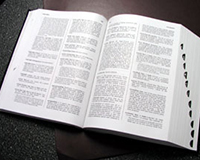The words “substantial” and “substantially” permeate SDLT legislation, but the same words can have different meanings in different contexts
“When I use a word,” Humpty Dumpty said in rather a scornful tone, “it means just what I choose it to mean – neither more nor less.”
You could be forgiven for thinking that the draftsman of the stamp duty land tax (“SDLT”) legislation must have been a fan of Through the Looking Glass. The words “substantial” and “substantially” appear no fewer than 40 times in the SDLT provisions of the Finance Act 2003 (as amended over the years), but without definition or consistent meaning.
Substantial performance
SDLT is usually payable on completion of a land transaction, when the transfer or lease is completed and the buyer or tenant acquires a legal estate in the property.
However, in order to outlaw “resting on contract” schemes that had become popular under the previous stamp duty regime, SDLT can become payable at an earlier stage if the contract is “substantially performed”.
The legislation tells us that a contract is substantially performed if the buyer either:
- takes possession of the whole, or substantially the whole, of the premises; or
- pays a substantial amount of the consideration.
But what do these phrases actually mean? Dictionaries define substantial and substantially using terms like “considerable” and “to a great extent”, but how does that translate into percentages?
Guidance from HM Revenue & Customs helpfully confirms its view that a substantial amount of the consideration means 90% or more, so we have something approaching certainty for that limb of the test (although, unlike Humpty Dumpty, HMRC does not have complete freedom to decide the meaning of a word; it is ultimately for the courts to decide). Relying on the HMRC guidance, if only 89% of the purchase price has been paid, there is no substantial performance, but if 90% has been paid, then SDLT is triggered.
There is no corresponding guidance as to what constitutes “substantially” the whole of the premises. Consistency dictates that a 90% test should apply here too, but if that is the case, then why does the guidance refer only to one limb of the test when it would be just as easy to refer to both? Does this omission from the guidance actually suggest that a different threshold applies to the possession test?
A recent transaction concerned an agreement for lease, under which the landlord was obliged to merge several previously separate units before granting a single lease of the new combined unit. The tenant was allowed into one of the old units in advance of the conversion works taking place. On any interpretation, occupation of one unit out of several cannot be said to be taking possession of substantially the whole of the premises. However, if the area to which the tenant is allowed access increases as the works progress, when can the tenant be said to be in possession of substantially the whole?
How significant is this? From a practical perspective, while lawyers and their clients may agonise over whether substantial performance has occurred, the self-assessment nature of SDLT makes it highly unlikely that this judgement call will be challenged. Assuming the transaction completes in due course, a land transaction return will be submitted and the tax paid, so in most cases the only real prejudice to HMRC will arise from the delay in receiving payment.
Overlap relief
Matters become more serious where the meaning of “substantially” affects the amount of tax ultimately payable, such as where overlap relief is claimed. This relief avoids the potential double taxation of rents on the surrender and regrant of a lease, allowing rents taxed under the original lease to be offset against those chargeable under the new lease.
For overlap relief to be available, one condition is that the new lease must be of “the same or substantially the same premises” as the lease being replaced. This is a different test than applies for relief on sale-and-leaseback transactions, where the requirement is simply that the leaseback is granted “out of” the interest that has been sold.
In a typical surrender and regrant situation, the new lease will be of exactly the same premises, but what if it isn’t? One leading commentator suggests using 80% as a rule of thumb, based on HMRC’s practice with other taxes.
However, the danger of looking for answers elsewhere is that it reveals a level of inconsistency of which Lewis Carroll would be proud. For example, HMRC guidance advises that the phrase “substantial extent” widely used in the Taxation of Chargeable Gains Act 1992 simply means “more than 20%”, a much lower threshold, while a “substantial shareholding” under that Act means a mere 10%.
Or suppose that a retailer is surrendering its lease of shop premises with unwanted residential accommodation above, in return for a new lease of the shop premises alone. Arguably, the test should focus on the overriding significance to the retailer of the shop premises, rather than the relative sizes of the residential and commercial accommodation.
Flexible uncertainty
The reality is that the meaning of words such as “substantial” and “substantially” will always depend on their context. “Substantial” can mean anything between 10% and 90% to HMRC, affording it the flexibility to do justice in any particular situation. The downside for taxpayers and their advisers is the resultant uncertainty and the possible need to seek clearance from HMRC in cases of doubt.
Bill Chandler is a professional support lawyer at Hill Dickinson LLP








